On our prior trip to Oaxaca in July 2017, we spent a lot of energy gaining a better understanding and appreciation for Mezcal. A big part of that understanding came from our day spent with Alvin Starkman on his widely acclaimed Mezcal Educational Excursions of Oaxaca. Since then we’ve been doing our own independent research (i.e. drinking the artisanal mezcals we brought home with us) so a good deal of our motivation for going back to Oaxaca in April 2018 was the chance to expand our palate and to replenish our stocks.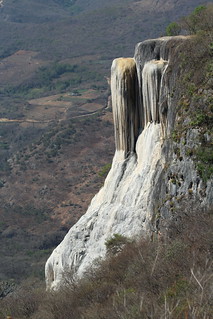
Towards that goal, we set out at 8:00 AM on our first morning in the direction of San Lorenzo Albarrda, the village that is home to El Mezcal Zompantle, one of our favorite palenques from 2017. On the way there, we took the opportunity of the early hour and the close by location to make a short stop at Hierve el Agua. You can read more about that visit in our Oaxaca 2018 report.
From Hierve el Agua we headed back into the village of San Lorenzo Albarrda and asked for directions to Mezcal Zompantle at the toll gate. We drove through town and out another road up the mountain.
We were beginning to think we were on the wrong road when we rounded a corner and found Master Mescalero Santos Martínez out in front of his building alternately supervising renovations on an 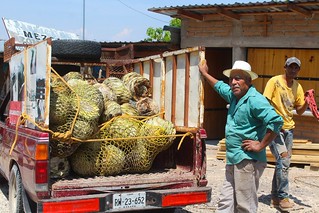
expanded covered space of “El Zompantle” and receiving pick-up truck loads of some beautiful agave piñas fresh from the new harvest. He told us the truck load shown in this picture was to make Tepeztate.
Even though we had visited Mezcal Zompantle on our previous trip, this was actually the first time we met Sr. Santos as he had been working in the field when we visited in July and his son Miguel served us samples of their mezcals. He was a very gracious and patient host and all-in-all, a very impressive man.
 Everything we tried that day was excellent. We had brought along 4 empty liter sized bottles with homemade pre-printed labels anticipating a purchase and ended up with 2 liters of Tepeztate, 1 of the Tobala and another of the Espadín Reposado . When we produced the bottles to be filled, Sr. Santos was very pleased to see his name on our labels.
Everything we tried that day was excellent. We had brought along 4 empty liter sized bottles with homemade pre-printed labels anticipating a purchase and ended up with 2 liters of Tepeztate, 1 of the Tobala and another of the Espadín Reposado . When we produced the bottles to be filled, Sr. Santos was very pleased to see his name on our labels.
As far as price compared to quality, “El Zompantle” represents the best value of any of our mezcal purchases. We were happy that we had brought 4 bottles but at that point, wished we had brought more. We also took the opportunity to fill an (empty) ½ liter water bottle with Tepeztate for Francisco at the hotel plus another with Tobala for our driver Augustine.
Back in Oaxaca City, on our way to dinner one evening we stopped in at the well regarded Mezcaleria In Situ located at 511 José María Morelos. This is a small bar with very friendly staff and an amazing array of artisanal mezcals. Some are from larger boutique makers and showed distinct maker labels but most were from smaller palenques much like the places we were visiting and showed the In Situ house label.
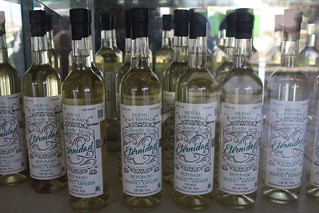 If you are unfamiliar with mezcal, In Situ is a great place to begin your education. Sit at the bar and order flights and let the bartender explain some of the nuances of flavor that you should be looking for. If you find something you really like, you can buy bottles of your favorites there.
If you are unfamiliar with mezcal, In Situ is a great place to begin your education. Sit at the bar and order flights and let the bartender explain some of the nuances of flavor that you should be looking for. If you find something you really like, you can buy bottles of your favorites there.
On our visit, we found empty seats at a table in a bay window half way up the stairs and ordered shots of a Toballa, which while good was not as pleasing to our taste as what we had bought at El Zompantle earlier that same day and a shot of what the specials menu called a “Horon”. I asked the bartender about it and he advised it was an uncommon distillation likely made from Agave Americana. Regardless, it was a mezcal I had never seen before or since that night.
Our last full day in Oaxaca on this trip was a Sunday so we got another early start and had Augustine drive us about 45-minutes out of the city to the famous Tlacolula Market, one of the largest markets in the region. We passed by quite a few booths for local distillers but passed on their offers for a sample as we already had plans for tastings on site at several palenques later in the day. You can read more about our visti to the Tlacolula Market in our Oaxaca 2018 report.
 From the Tlacolula Market we headed 16 km down Highway 190 and just after entering Santiago Matatlán, the self-proclaimed “Mezcal Capital of the World” we made a stop at another place we had visited before known as both Mezcal Desde La Eternidad and Mezcal La Curva. Whatever you call it is the palenque of Master Mezcalero Juan Hernández and his hand crafted mezcals are prized even in a region that is the center of the Mezcal Universe.
From the Tlacolula Market we headed 16 km down Highway 190 and just after entering Santiago Matatlán, the self-proclaimed “Mezcal Capital of the World” we made a stop at another place we had visited before known as both Mezcal Desde La Eternidad and Mezcal La Curva. Whatever you call it is the palenque of Master Mezcalero Juan Hernández and his hand crafted mezcals are prized even in a region that is the center of the Mezcal Universe.
When we had visited there before one of his daughters was our host but on this day. Sr. Juan, his wife and two of his daughters all joined in the fun. It was obvious this was a man who was proud of his family and proud of his product and he seemed genuinely happy to be able to share the fruits of his labor with us.
The La Eternidad Tepeztate is one of our very favorite mezcals we brought home from our first trip to Oaxaca and we knew before we walked in the door we would be buying several bottles of that but Sr. Juan had other varietals he wanted to share with us.
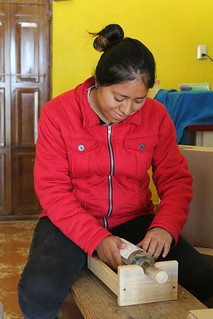 We tried Reposados of several different agaves and different lengths of time in the aging barrel and more than one were tempting. We kept taking little sips of one and then another trying to distinguish characteristics of each but by the time we finished we were in a state of happy confusion.
We tried Reposados of several different agaves and different lengths of time in the aging barrel and more than one were tempting. We kept taking little sips of one and then another trying to distinguish characteristics of each but by the time we finished we were in a state of happy confusion.
We tried a very interesting Espadin flavored with 15 local herbs.
He poured samples of Mezcal Cerrudo; made from a very rare wild agave that can take up to 25 years to mature. It was our first ever taste of Cerrudo and we liked it enough to bring a bottle home with us.
But our favorite discovery at Sr. Juan’s shop was a bottle simply labeled “Ensemble”, which turned out to be a blend of our two favorite mezcals: Tepeztate and Tobala. It had a delightful smooth taste we are enjoying now here in the U.S.
As we were trying to pull everything together and walk out the door Sr. Juan stopped us. He had one more for us to taste.
Most mezcals are tempered to 45% alcohol content but Sr. Juan had some Espadin Jovin cranked up to 55% that he wanted us to try. It was a bit hot but very tasty. We didn’t buy any of that one but we did leave the shop with a big grin on our face.
 So we finally made it out the door and didn’t have far to go to our next stop. Right across the street we could see the sign for Mezcal Gracias a Dios (translated literally as Thank God Mezcal.) The Maestro Mezcalero here is Sr. Óscar Hernández Santiago. Not only does Sr. Óscar make some delicious mezcal, he is one of the more forward thinking distillers in the region.
So we finally made it out the door and didn’t have far to go to our next stop. Right across the street we could see the sign for Mezcal Gracias a Dios (translated literally as Thank God Mezcal.) The Maestro Mezcalero here is Sr. Óscar Hernández Santiago. Not only does Sr. Óscar make some delicious mezcal, he is one of the more forward thinking distillers in the region.
This is not a large operation but the grounds are beautifully maintained and he has examples of very healthy clearly labeled specimen plantings of different agaves so visitors can identify the plant with the finished product.
He led us to his distillation pots and allowed us to taste a first distillation (typically at about 35% alcohol) as it dripped from the pot. Muy suave.
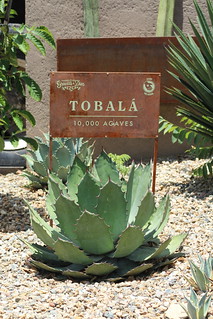
Sr. Óscar does a very good job at making all the typical varietals that all the other locals Mezcaleros are making.
But he wanted to separate his palenque from the pack and offer a unique product so he formed an alliance with students of Oaxaca State University to develop a recipe infusing 32 herbs into triple distilled Espadín liquor to produce and market an agave based Gin. And it is such a terrific bottle that we had to bring (several) home with us.
In my research since we’ve returned to the U.S. I’ve found a couple sources for his Gin in retail stores in a few pockets of the country.
.
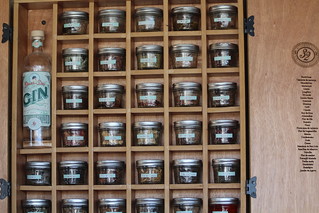
We sampled another unique offering from Sr. Óscar: a tart mango infused mezcal. A bottle of that is in the foreground of the above photo of Sr. Óscar. If we had made this stop earlier in the week we would have bought some of that one too but at that point we knew we were already past the maximum we could possibly pack in our suitcases.
After our visit at Mezcal Gracias a Dios we returned to the car and were happy we had Sr. Augustin to drive us the roughly 1-hour back to Oaxaca City. It had been a memorable day.
